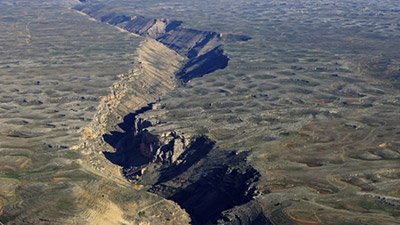
Rocks Tell us About Scientists
BBC News: “Early Rocks to Reveal Their Ages” Scientists have honed a geological technique to piece together the history of tectonic plates.
The technique focuses on the magnetic signature formed when magma fills in cracks formed as continental plates move. The scientists say they can determine the orientation and latitude of the resulting basalt by studying the rocks’ magnetic signature. Furthermore, when combined with radiometric dating, different sets of rocks can be matched up from around the globe, showing which were part of the same volcanic or tectonic event.
“All we need to do is measure the amounts of uranium and lead very precisely.”
The problem is that the technique requires the extraction of tiny mineral crystals that may be less than 100 microns (millionths of a meter) long. Previously, this was a significant complication. But now, the BBC reports, new methods permit successful recovery of these minerals.
One such mineral is baddeleyite, which is used for radiometric dating because of its uranium content. Uranium radioactively decays into lead at a certain rate; so, the uranium and lead content of a rock is often used to determine its age. The disagreement between old-earthers and young-earthers on this issue centers on such questions as whether we can know if the rate has always been the same and how we can know whether other factors influenced the elemental composition of rocks.
“All we need to do is measure the amounts of uranium and lead very precisely,” said Michael Hamilton, one geologist on the project. Of course, considering the sizes and weights of the extracted minerals, that’s no small task.
Geologists hope to collect 250 rock samples from around the world and use their technique to estimate the location of landmasses 2.5 billion years ago. Already, the team has “discovered” that Canada once bordered Zimbabwe.
Plate tectonics plays an important role in the creation model of geology, and most young-earth creationists certainly support the idea that the continents were once arranged differently; the primary difference between old-earthers and young-earthers concerns the timetable and exact mechanisms of tectonic events. But radiometric dating is founded on several problematic assumptions, and, thus, this new technique, as it is in part based on dating rocks, is likewise questionable.
The next test will be whether the result of the 250 rock samples supports other predictions of the plate tectonics model. If the evidence matches up, this method may have merit—despite the role of radiometric dating (indeed, similar radiometric “dates” may show rocks were formed in proximity, albeit not as long ago as some believe). However, if the evidence clashes with previously established ideas, the technique will demonstrate the flaws in radiometric dating—not that the mainstream scientists will interpret it as such.
For more information:
Remember, if you see a news story that might merit some attention, let us know about it! (Note: if the story originates from the Associated Press, Fox News, MSNBC, the New York Times, or another major national media outlet, we will most likely have already heard about it.) And thanks to all of our readers who have submitted great news tips to us.
(Please note that links will take you directly to the source. Answers in Genesis is not responsible for content on the websites to which we refer. For more information, please see our Privacy Policy.)
Recommended Resources

Answers in Genesis is an apologetics ministry, dedicated to helping Christians defend their faith and proclaim the good news of Jesus Christ.
- Customer Service 800.778.3390
- Available Monday–Friday | 9 AM–5 PM ET
- © 2025 Answers in Genesis



